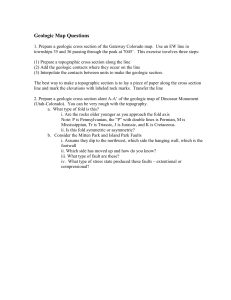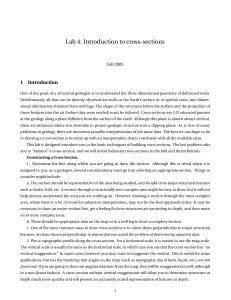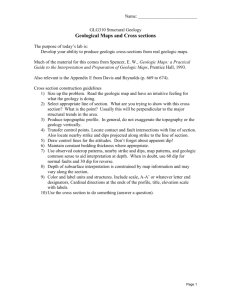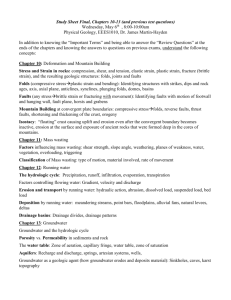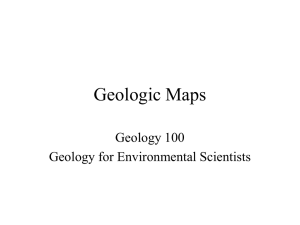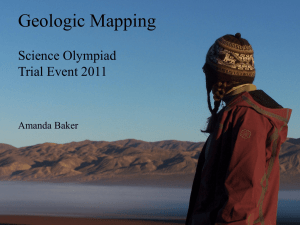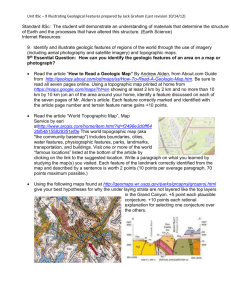cross section lab
advertisement
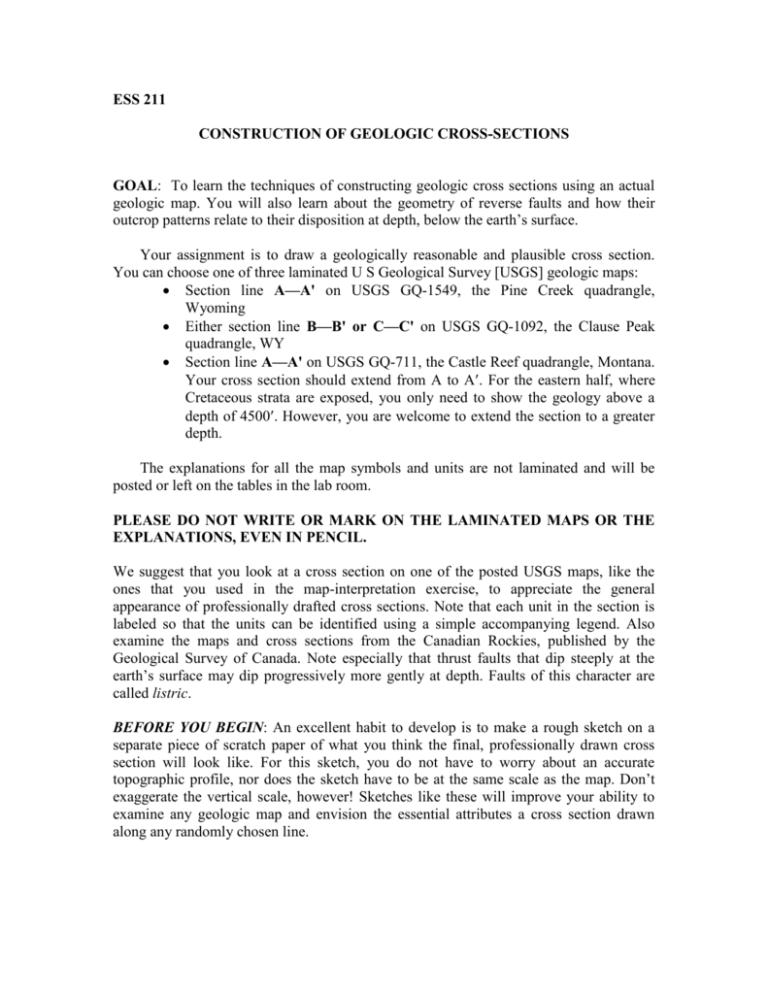
ESS 211 CONSTRUCTION OF GEOLOGIC CROSS-SECTIONS GOAL: To learn the techniques of constructing geologic cross sections using an actual geologic map. You will also learn about the geometry of reverse faults and how their outcrop patterns relate to their disposition at depth, below the earth’s surface. Your assignment is to draw a geologically reasonable and plausible cross section. You can choose one of three laminated U S Geological Survey [USGS] geologic maps: Section line A—A' on USGS GQ-1549, the Pine Creek quadrangle, Wyoming Either section line B—B' or C—C' on USGS GQ-1092, the Clause Peak quadrangle, WY Section line A—A' on USGS GQ-711, the Castle Reef quadrangle, Montana. Your cross section should extend from A to A. For the eastern half, where Cretaceous strata are exposed, you only need to show the geology above a depth of 4500. However, you are welcome to extend the section to a greater depth. The explanations for all the map symbols and units are not laminated and will be posted or left on the tables in the lab room. PLEASE DO NOT WRITE OR MARK ON THE LAMINATED MAPS OR THE EXPLANATIONS, EVEN IN PENCIL. We suggest that you look at a cross section on one of the posted USGS maps, like the ones that you used in the map-interpretation exercise, to appreciate the general appearance of professionally drafted cross sections. Note that each unit in the section is labeled so that the units can be identified using a simple accompanying legend. Also examine the maps and cross sections from the Canadian Rockies, published by the Geological Survey of Canada. Note especially that thrust faults that dip steeply at the earth’s surface may dip progressively more gently at depth. Faults of this character are called listric. BEFORE YOU BEGIN: An excellent habit to develop is to make a rough sketch on a separate piece of scratch paper of what you think the final, professionally drawn cross section will look like. For this sketch, you do not have to worry about an accurate topographic profile, nor does the sketch have to be at the same scale as the map. Don’t exaggerate the vertical scale, however! Sketches like these will improve your ability to examine any geologic map and envision the essential attributes a cross section drawn along any randomly chosen line. STEP 1. SKETCH A TOPOGRAPHIC PROFILE. On your piece of Clearprint drafting film, construct a section box with a vertical scale equal to the horizontal scale of the map. Trace a topographic profile from those provided in lab. STEP 2. ADD STRUCTURAL AND STRATIGRAPHIC DATA. Just like you did in the earlier, simple cross-section exercises, mark contacts and faults on the topographic profile. These surface data are the most important controls for projecting the contacts, units, and structures to depth. The locations of the contacts in particular cannot be fudged. To estimate the dips of the units and the contacts, use the strike-and-dip symbols closest to the section line. Don’t worry if the section line is not exactly perpendicular to the strikes. You can correct the dip measured in the field to an apparent dip using the nomogram from an earlier lab exercise. You will probably have to choose an average strike and dip to account for the natural and actual variability of attitudes in the field. LOOK ON EITHER SIDE OF THE SECTION LINE, along the strike of the units, to see if there are units or structures present that will appear on the cross-section below the surface. We say that these project into the line of section. For example, a unit that does not crop out along your section line may crop out along strike. This common situation will give you confidence that the unit is present at depth along your section. HOW DEEP AND HOW HIGH? You have to decide how much of the blank area below the earth's surface you want to fill in with geology. The general guideline we use: include those units and structures that you are fairly confident are present. Try to fill in a strip that extends approximately 2000-3000 feet below the topographic profile [note the instructions above about Castle Reef section A—A']. If you show something in a cross section, you should be able to explain to a skeptic the reasoning behind your action. You might say, for example, “This unit crops out one km north of the section line and there it dips to the south.” If folds or faults are present in your section, you can dash them into the air above the surface to indicate their general form. After all, these features and the rocks that they affect used to occupy this space before they were eroded! You may choose to leave part of the section box blank, because you are not confident enough about the rocks and structures actually present. KEEP IN MIND that these rocks were all deformed in the upper crust at relatively low temperatures and pressures. Therefore, each unit will retain a relatively constant thickness in the cross section. You will probably find that you will have to slightly adjust the dips plotted at the surface to ensure that this attribute is respected. CHECK FOOTWALL AND HANGING-WALL CUTOFFS. If your section portrays a hanging-wall cutoff and a footwall cutoff that you infer were matched prior to slip along a reverse fault, the template constraint requires that all of the beds that are truncated by the fault in either cutoff are matched by those in the other. STEP 3. LABEL AND COLOR THE UNITS & LABEL THE STRUCTURES. Use the abbreviations on the maps (e.g. Kgu). Use normal line-widths for contacts, and 2 heavier lines for faults. Be sure to include a horizontal scale, and plot elevations along both sides of the section. Your colors do not have to exactly match those on the map, but it’s a good idea to take them from the same part of the spectrum. ENSURE THAT YOUR SECTION HAS A PROFESSIONAL APPEARANCE. You do not need to print labels using a computer, but try to make your lettering, line work, and coloring as neat as possible. A FEW THINGS TO KEEP IN MIND: STRAIGHT EDGES MAKE STRAIGHT LINES. They are great for drawing the boundaries of the section box and underlining words. Don't use a straight edge for drawing folds and faults in your sections, especially where you can depict faults as listric. GRADING. Your score will be based on criteria including location and orientation of folds, faults, and bedding; legend, labels; geologic plausibility; and neatness. NO separate write-up or discussion is necessary. CHECK LIST OF ITEMS THAT SHOULD BE PRESENT ON YOUR CROSS SECTION: Title (Cross section A-A´, Pine Creek…] Scale bar; V = H Your name Colored boxes for each geologic unit shown on the section For each box, name of the unit and its age Names of major faults and folds identified on the geologic map 3
